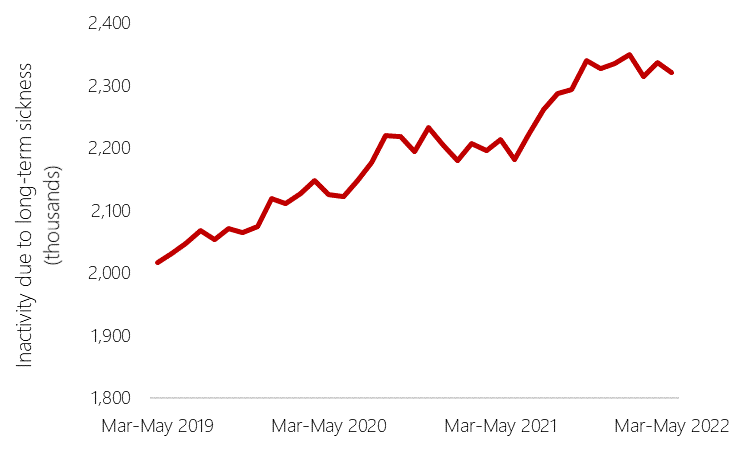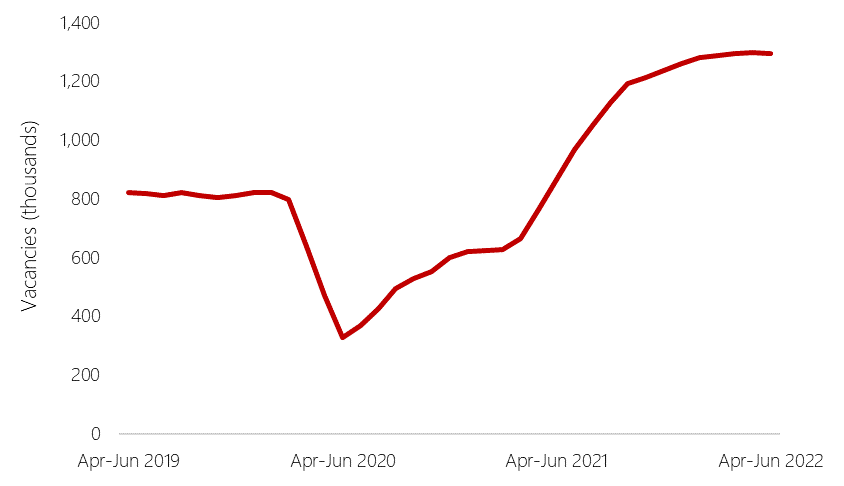The new Prime Minister will inherit a challenging labour market as the cost of living crisis bites
Posted on
 © Photo by Yaopey Yong on Unsplash
© Photo by Yaopey Yong on Unsplash
Today’s labour market data continues to show a very mixed picture. While the number of people in employment in the spring increased by 0.4 percentage points on the quarter to 76%, this is still below pre-pandemic levels.
Positively, the unemployment rate for March to May 2022 decreased by 0.1 percentage points on the quarter to 3.8%. However, short-term unemployment – those unemployed for up to six months – increased over the latest three-month period at the fastest rate since late 2020.
Economic inactivity
A persistent participation problem continues to undermine economic recovery, with 8.7 million people currently out of work and not looking for work. Termed economic inactivity, this has increased by 5% since the pandemic took hold in the UK in January 2020.
While the overall economic inactivity rate decreased by 0.4 percentage points on the quarter to 21.1%, the number of people who are inactive due to long-term sickness remains stubbornly high at 2.3 million.
Figure 1: Economic inactivity due to long-term sickness, March to May 2019 – March to May 2022

Source: Work Foundation calculations based on ONS (19th July) Dataset A01 July - Economic inactivity for those aged from 16 to 64 (seasonally adjusted)
Supporting those who are currently experiencing long-term sickness back into work when they are ready will not be a straightforward process. These individuals are likely to require more intensive support to help them find the right job and stay in work long-term.
Vacancies
While the number of vacancies between April and June 2022 remains historically high at 1.29 million, this is starting to slow down. There was a spike in vacancies in 2020 following the easing of restrictions, and this has remained high ever since, although we are no longer seeing a record number of vacancies every month.
Figure 2: All vacancies (seasonally adjusted), April to June 2019 – April to June 2022

Source: Work Foundation calculations based on ONS (19th July) Dataset A01 July – Vacancies by industry (seasonally adjusted)
Between March and May there were more vacancies than unemployed people, however, employers in many industries are still struggling to recruit staff with the skills that they need. New analysis from the Recruitment and Employment Confederation highlights the economic impact of these shortages, and makes clear that any attempts to boost demand as a means to speed up recovery whilst there are labour shortages that cannot be filled will likely impact the economy negatively in the medium term. Their modelling suggests that a 10% increase in demand in the economy would need to be accommodated by 1.7 million new jobs, and without this employment increase, real UK GDP would fall by between £30 billion and £39 billion every year from 2024 through to the end of 2027.
Last month, we highlighted that if flexibility remains limited to certain worker groups and sectors of the economy, employers will struggle to attract and retain people who face barriers to entering and remaining in work. A vast pool of talent is being overlooked amongst disabled people currently out of work. New Work Foundation research found that access to remote working is essential or very important for 80% of disabled workers that we surveyed, so given the right conditions and flexibility to thrive, disabled people could help alleviate the shortages we see across the country.
Pay
Today’s labour market data shows the biggest drop in real terms pay since 2001. Real wages (excluding bonuses) are down by a record 2.8% on the year, as inflation wipes out regular pay increases of 4.3%.
Private sector pay is significantly outpacing pay in the public sector, and Government’s response to this will come later today with the announcement of the public sector pay deal. If public sector jobs can’t keep up with rising living costs, it is hard to see how they can remain competitive, especially given that other terms and conditions such as pension packages are becoming less attractive.
Inflation hit 9.1% in June 2022, with the increasing cost of food, energy bills and fuel putting pressure on households' finances. According to the British Retail Consortium, retail sales are falling at a rate "not seen since the depths of the pandemic", as price rises hit household budgets. Furthermore, food inflation could reach 15% this summer according to forecasts by the Institute of Grocery Distribution (IGD), meaning shoppers will be paying more for their essential groceries.
Each month, the severity of the cost of living crisis that we are falling into becomes clearer the data. UK GDP is projected to increase by 3.6% in 2022, before stagnating in 2023. Furthermore, money saving expert Martin Lewis has warned that a ‘financial cataclysm’ will hit the UK when the new Prime Minster takes up their post in September, potentially devastating lives if mitigating action is not taken. Government can do more to protect those who are most financially vulnerable.
The Conservative Party leadership candidates have so far failed to demonstrate that they grasp the severity of the cost of living crisis and what it means for millions of people across the country.
The Prime Minister will be chosen by Conservative party members, which represent a tiny proportion of British voters. Their members are older and wealthier than average UK voter and are unlikely to be suffering the same squeeze as many working families. It’s essential that candidates cast their minds forwards to the autumn – when energy prices will rise again - and build a plan to manage the crisis that will support all workers across the UK. In the longer-term, the next Prime Minister must bring forward ambitious legislation to reform the rights of workers, improve job quality and make the labour market work for everyone.
Disclaimer
The opinions expressed by our bloggers and those providing comments are personal, and may not necessarily reflect the opinions of Lancaster University. Responsibility for the accuracy of any of the information contained within blog posts belongs to the blogger.
Back to blog listing

